Belt flowers
| Belt flowers | ||||||||||||
|---|---|---|---|---|---|---|---|---|---|---|---|---|

Tapinanthus rubromarginatus on Faurea saligna in Waterberg , South Africa |
||||||||||||
| Systematics | ||||||||||||
|
||||||||||||
| Scientific name | ||||||||||||
| Loranthaceae | ||||||||||||
| Yuss. |
The belt flowers (Loranthaceae) are a family of plants within the order of the sandalwood-like (Santalales). The approximately 73 genera with approximately 950 species thrive from the temperate climatic zones through the subtropics to the tropics , mainly in the southern hemisphere ("Gondwanian" distribution). These mistletoe-like plants are semi-parasites ( semi-parasites ) and in at least one case ( Tristerix aphyllus ) fully parasites on perennial plants: woody plants or succulents. - Please note that the German name Riemenblume is not only used for the genus Loranthus , which gives it its name , but also for the genus Loropetalum of the witch hazel family (Hamamelidaceae).
description
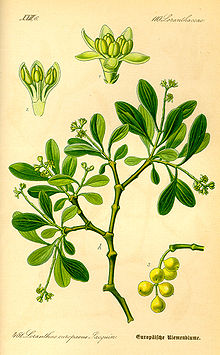


Appearance and leaves
They grow evergreen, usually shrub-like, or as independently upright shrubs , rarely as trees (well-developed specimens of Nuytsia floribunda ) or less often as lianas ( e.g. Tristerix ). The secondary growth in thickness occurs via a conventional cambium ring or abnormally via a concentric cambium ( Nuytsia floribunda ).
In some species, the leaves are reduced and photosynthesis takes place via green, often winged branches. Most species have well-developed leaves. The mostly opposite leaves have a simple, entire, often leathery or fleshy, more rarely membranous leaf blade. There are no stipules .
Inflorescences and flowers
The flowers are clustered, zymose , racemose , spiky or dold-like inflorescences . The flowers stand over a pair of bracts that are fused and form a calyx.
The flowers are mostly hermaphroditic, but there are rarely species with unisexual flowers ( Nuytsia floribunda , Loranthus europaeus ). The individuals of these species are either monoecious, separate sexes ( monoecious ) or dioecious like the eponymous belt flower itself. The flowers are more or less radial symmetry and usually five or sixfold (three to ninefold). The flower base (recipe) is clearly hollow. There is no flower cup (hypanthium). There may be three to nine clear or overgrown sepals , but they can also be more or less reduced until only a lobed to toothed cup or ring is recognizable. The sepals are already open in the flower bud and are durable. The three to nine petals can be free; but in very many genera they have grown together to form a tube. The often curved corolla tube can be split on one side and the corolla can be two-lipped. The color of the petals ranges from yellow to orange to red. There is only the inner circle with mostly five or six (three to nine) fertile stamens . The stamens are free from each other, but fused with the petals. The anthers often open explosively with a longitudinal slit. The two-celled pollen grains usually have three or less often four apertures and are colpat; there are no apertures in Atkinsonia . Three or four carpels are one under permanent, single-chamber ovary grown. There are four to twelve sedentary, undifferentiated ovules in the basal placentation .
Fruits and seeds
The closing fruits are mostly fleshy, rarely non-fleshy (for example in Nuytsia floribunda ). Almost all species form berries , a few species form stone fruits , only in Nuytsia floribunda are winged nuts .
The seeds contain a lot of oily endosperm . The seeds do not have a seed coat (testa); rather, they are encased in a sticky pulp. The well-differentiated, chlorophyll-containing embryo has one or two cotyledons, which are often connected to one another.
Chromosome numbers
The basic chromosome numbers are x = 8 to 12.
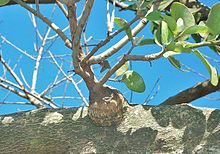
ecology
Way of life
They live as lignified semi-parasites ( semi-parasites ) on the aboveground parts of trees and bushes or (rarely) on the roots of the host plants. In many species there are no roots in the true sense, but their contact organs are more like haustoria .
pollination
Many species have relatively large, showy red or yellow-colored long-tubular flowers that are pollinated by birds ( ornithophilia ). In the other species with smaller and more inconspicuous flowers, pollination is carried out by insects ( entomophilia ). The only species native to Europe , the deciduous oak mistletoe ( Loranthus europaeus ), has inconspicuous, dioecious yellowish flowers.
Systematics and distribution
The Loranthaceae family was listed in 1808 by Antoine Laurent de Jussieu in Annales du Museum National d'Histoire Naturelle , Volume 12, p. 292. The type genus is Loranthus Jacq. Synonyms for Loranthaceae Juss. are: Elytranthaceae Tiegh. , Gaiadendraceae Tiegh. ex Nakai , Nuytsiaceae Tiegh. , Treubellaceae Tiegh. nom. illeg., Psittacanthaceae Nakai .
Most species of the belt flower family come from the temperate climatic zones over the subtropics to the tropics , mainly in the southern hemisphere . In southeastern Central Europe , only the oak mistletoe ( Loranthus europaeus ) belongs to this family.
The mistletoe of the genus Viscum , which is also native to Central Europe, and other genera related to it, which have long been placed in a separate family Viscaceae, are now grouped into the family of the sandalwood family (Santalaceae) according to controversial recent findings .

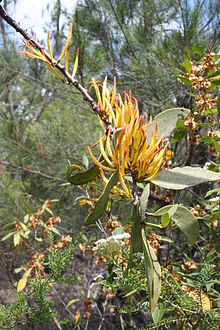



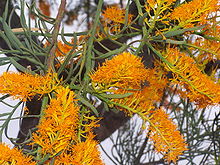
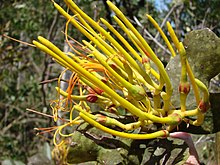

There are 65 to 73 genera in the Loranthaceae family:
-
Actinanthella Balle : There is only one kind (or with a second type, both coming in Africa before):
- Actinanthella menyharthii (Engl. & Schinz) balls
- Aetanthus (Eichler) Engl .: The approximately 10 species thrive in the northern Andes .
- Agelanthus Tiegh. (Syn .: Acranthemum Tiegh. , Dentimetula Tiegh. , Schimperina Tiegh. ): The approximately 59 species are common in Africa and Arabia .
-
Alepis Tiegh. : There is only one type:
- Alepis flavida (Hook. F.) Tiegh. : It occurs in New Zealand .
- Amyema Tiegh. (Syn .: Candollina . Tiegh , Cleistoloranthus . Merr , Dicymanthes Danser , Neophylum Tiegh. , Pilostigma Tiegh. , Rhizanthemum Tiegh. , Rhizomonanthes Danser , Stemmatophyllum Tiegh. , Ungula Barlow , Xylochlamys Dominguez ): The 95 to 100 species of Southeast Asia over the Philippines to New Guinea as well as Australia (about 36 species) and the Samoa Islands .
- Amylotheca Tiegh. : The roughly five species occur from Melanesia to New Guinea, New Caledonia and eastern Australia (two species).
-
Atkinsonia F. Muell. : There is only one type:
- Atkinsonia ligustrina (Lindl.) F. Muell. : This endemic thrives only in the Blue Mountains in southeastern Australia.
- Bakerella Tiegh. : Of the 16or sospecies, 15 occur only in Madagascar , one also occurs in the Seychelles .
-
Benthamina Tiegh. : There is only one type:
- Benthamina alyxifolia (Benth.) Tiegh. : This endemic occurs only in eastern Australia.
-
Berhautia Balle : There is only one type:
- Berhautia senegalensis Balle : It occurs in Senegal and Gambia .
-
Cecarria Barlow : There is only one type:
- Cecarria obtusifolia (Merr.) Barlow : It occurs in the Philippines , Flores and Timor and on the Cape York Peninsula in northern Queensland .
- Cladocolea Tiegh. : The approximately 26 species are common in Central America .
- Cyne Danser (Syn .: Tetradyas Danser ): The six or so species occur from the Philippines to New Guinea.
- Dactyliophora Tiegh. : The only two or three species occur on Seram , in Papuaia, and one species is also found on the Cape York Peninsula in northern Queensland .
- Decaisnina Tiegh. : The 25 to 30 species occur from Java and the Philippines to northern Australia, Tahiti and the Marquesas .
- Dendropemon (flower) Rchb. : The approximately 20 species occur on Caribbean islands.
- Dendrophthoe Mart. : The 30 to 38 species are common in the tropics of Africa, Asia and Australia. A focus of biodiversity is in western Malesia.
-
Desmaria Tiegh. : There is only one type:
- Desmaria mutabilis (Poepp. & Endl.) Tiegh. ex T.Durand & BDJacks. : It occurs in Chile .
- Diplatia Tiegh. : The three or so species occur in tropical Australia.
- Distrianthes Danser : The one to three species occur in New Guinea.
- Elytranthe (flower) flower : The only two species occur from India to Vietnam and in western Malesia .
-
Emelianthe Danser : There is only one type:
- Emelianthe panganensis (Engl.) Danser : Soe occurs in East and Northeast Africa .
- Englerina Tiegh. : The approximately 25 species occur in tropical Africa.
- Erianthemum Tiegh. : The 16 or so species occur in East and South Africa.
-
Gaiadendron G.Don : There is only one type:
- Gaiadendron punctatum (Ruiz & Pav.) G.Don : It occurs in the Neotropic.
- Globimetula Tiegh. : The approximately 13 species occur in tropical Africa.
-
Helicanthes Danser : There is only one type:
- Helicanthes elasticus (Desvaux) Danser : It occurs in India.
- Helixanthera Lour. : The approximately 45 species occur from tropical Africa to Sulawesi .
-
Ileostylus Tiegh. : There is only one type:
- Ileostylus micranthus (Hook. F.) Tiegh. : It occurs in New Zealand.
- Ixocactus Rizzini : The seven or so species occur in Colombia and Venezuela .
-
Kingella Tiegh. (is also put to Trithecanthera ): There is only one kind:
- Kingella scortechinii (King) Tiegh. : It occurs in Malaysia .
-
Lampas Danser : There is only one type:
- Lampas elmeri (Merr.) Danser : This endemic occurs in northern Borneo .
- Lepeostegeres flower (Syn .: Choristegeres Tiegh. , Choristegia Tiegh. , Stegastrum Tiegh. ): The nine species occur from Malesia to New Guinea.
- Lepidaria Tiegh. ( Chorilepidella Tiegh. , Chorilepis Tiegh. , Lepidella Tiegh. ); with about eight species, they occur from Thailand to Malesia
- Ligaria Tiegh. : There are about two species in South America.
-
Loranthus Jacq. : There are one to eight types, including:
- Oak mistletoe ( Loranthus europaeus Jacq. ): It is the only European species in this family.
-
Loxanthera (flower) flower : there is only one type:
- Loxanthera speciosa flower: It occurs on the Malay Peninsula, in Sumatra, Borneo and Java.
-
Lysiana Tiegh. : The eight or so species occur only in Australia, including:
- Lysiana casuarinae (Miq.) Tiegh. : This endemic thrives in semi-arid woodlands from the Hamersley Range to Norseman in Western Australia. It parasitizes on several tree species, mainly from the Casuarinaceae family, Acacia and Exocarpos species.
- Macrosolen (flower) Rchb. : The approximately 30 species occur from South Asia to New Guinea.
-
Moquiniella Ball : There is only one type:
- Moquiniella rubra (A.Spreng.) Balls . It occurs in South Africa.
- Muellerina Tiegh. (Syn .: Furcilla Tiegh. , Hookerella Tiegh. ): The four or five species occur in eastern Australia.
-
Notanthera (DC.) G.Don (Syn .: Phrygilanthus Eichler ): There is only one species:
- Notanthera heterophylla (Ruiz & Pav.) G.Don : It occurs in South America.
-
Nuytsia R.Br. ex G.Don : There is only one type:
- Nuytsia floribunda (Labill.) R.Br. : This endemic thrives in arid regions in southwestern Western Australia .
- Oedina Tiegh. : The fouror sospecies occur in Tanzania and Malawi .
- Oliverella Tiegh. : The three or so species are common in Africa.
- Oncella Tiegh. : The four or so species occur in tropical East Africa .
- Oncocalyx Tiegh. : The approximately 13 species occur in South and East Africa as well as in Arabia .
- Oryctanthus (Griseb.) Eichler (Syn .: Allohemia Raf. , Glutago Comm. Ex Poir. ): The approximately eleven species are common in the Neotropic.
- Oryctina Tiegh. : The eight or so species occur in South America.
-
Panamanthus Kuijt : There is only one species:
- Panamanthus panamensis (Rizzini) Kuijt : It is only found in Panama .
-
Papuanthes Danser : There is only one type:
- Papuanthes albertisii (Tiegh.) Danser : It occurs in New Guinea.
-
Pedistylis Wiens : There is only one type:
- Pedistylis galpinii (Schinz ex Sprague) Vienna : It occurs in South Africa.
- Peraxilla Tiegh. (Syn .: Neamyza Tiegh. , Perella (Tiegh.) Tiegh. ): There are about two species in New Zealand.
- Phragmanthera Tiegh. : The approximately 34 species occur in tropical Africa and Arabia .
- Phthirusa Mart. : The approximately 40 species are common in the Neotropic.
- Plicosepalus Tiegh. : The 12 or so species are common in Africa and Western Asia.
- Psittacanthus Mart. : The approximately 50 species are common in the Neotropic.
- Scurrula L .: About 20 species occur from South Asia to China and on the Moluccas .
- Septulina Tiegh. : The only two species occur in South Africa and southern Namibia .
- Socratina Balle : The three species that have been around since 2014 only occur in Madagascar.
-
Sogerianthe Danser : There is only one type:
- Sogerianthe sogerensis (S.Moore) Danser
-
Spragueanella Balle : There is only one type:
- Spragueanella rhamnifolia (Engl.) Balle : It occurs in Africa.
- Struthanthus Mart. (Syn .: Eichlerina Tiegh. , Peristethium Tiegh. , Ptychostylus Tiegh. , Spirostylis C. Presl ex Schult. & Schult. F. , Steirotis Raf. ): The approximately 50 species are common in the Neotropic .
- Tapinanthus (flower) Rchb. (Syn .: Acrostephanus Tiegh. , Lichtensteinia J.C.Wendl. Nom. Inval.): The 33 or so species occur in southern and tropical Africa and one species also reaches Yemen .
- Taxillus Tiegh. (Syn .: Locella Tiegh. , Phyllodesmis Tiegh. ): The approximately 35 species occur from tropical Asia to Malesia and on the coast of Kenya .
-
Thaumasianthes Danser : There is only one type:
- Thaumasianthes amplifolia (Merr.) Danser : It occurs in the Philippines.
- Tolypanthus (flower) Rchb. : The approximately five species occur from India to southeast China .
-
Trilepidea Tiegh. : There is only one type:
- Trilepidea adamsii (Cheeseman) Tiegh. : This endemic only occurs on the North Island of New Zealand.
- Tripodanthus (Eichler) Tiegh. : The three or so species occur in South America.
- Tristerix Mart. (Syn .: Epicoila Raf. , Metastachys (Benth. & Hook. F.) Tiegh. ): The approximately eleven species occur in South America.
- Trithecanthera Tiegh. (Syn .: Beccarina Tiegh. , Kingella Tiegh. ): The five or so species occur in western Malesia.
-
Tupeia Cham. & Schltdl. : There is only one type:
- Tupeia antarctica ( G. Forst .) Cham. & Schltdl. : It occurs in New Zealand.
-
Vanwykia Wiens : There is only one type:
- Vanwykia remota (Baker & Sprague) Vienna : It occurs in Southeast Africa .
swell
- DL Nickrent et al .: A revised classification of Santalales. In: Taxon , Volume 59, 2010, pp. 538-558. (Section systematics)
- The family of Loranthaceae in APWebsite . (Section systematics)
- The Loranthaceae family at DELTA by L. Watson & MJ Dallwitz. (Sections Description and Distribution)
- Daniel L. Nickrent, Lytton J. Musselman: Introduction to Parasitic Flowering Plants. In: The Plant Health Instructor , St. Paul, 2004: online. doi: 10.1094 / PHI-I-2004-0330-01 (section ecology)
- Huaxing Qiu, Michael G. Gilbert: Loranthaceae , pp. 220-239 - online with the same text as the printed work , In: Wu Zhengyi, Peter H. Raven, Deyuan Hong (ed.): Flora of China. Volume 5: Ulmaceae through Basellaceae. Science Press and Missouri Botanical Garden Press, Beijing and St. Louis 2003, ISBN 1-930723-27-X . (Section description)
- BA Barlow: Loranthaceae Flora of Australia Online , with data from Flora of Australia , Volume 22, ABRS, 1984.
Individual evidence
- ↑ First publication scanned at biodiversitylibrary.org .
- ↑ a b Loranthaceae at Tropicos.org. Missouri Botanical Garden, St. Louis, accessed January 23, 2013.
- ↑ Loranthaceae in the Germplasm Resources Information Network (GRIN), USDA , ARS , National Genetic Resources Program. National Germplasm Resources Laboratory, Beltsville, Maryland. Retrieved January 23, 2013.
- ^ A b David John Mabberley: Mabberley's Plant-Book. A portable dictionary of plants, their classification and uses. 3rd edition, Cambridge University Press 2008, ISBN 978-0-521-82071-4 .
- ↑ a b c d e f g h i j k l m BA Barlow: Loranthaceae Flora of Australia Online , with data from Flora of Australia , Volume 22, ABRS, 1984.
- ↑ a b Loranthaceae at Tropicos.org. In: Catalog of the Vascular Plants of Madagascar . Missouri Botanical Garden, St. Louis
- ^ Bryan A. Barlow: Conspectus of the Genera Amylotheca, Cyne, Decaisnina, Lampas, Lepeostegeres, and Loxanthera (Loranthaceae). In: Blumea , Volume 38, 1993, page 115.
Web links
- The family of Loranthaceae at parasiticplants .
- Loranthaceae at Tropicos.org. In: Flora of Pakistan . Missouri Botanical Garden, St. Louis
- Loranthaceae at Tropicos.org. In: Flora of Panama (WFO) . Missouri Botanical Garden, St. Louis
- Loranthaceae at Tropicos.org. In: Flora de Nicaragua . Missouri Botanical Garden, St. Louis
- Datasheet at Florachilena .
- Datasheet at eFlora of India .
further reading
- BA Barlow. Loranthaceae. Pp. 209-401, In: C. Kalkman et al. (Ed.): Flora Malesiana. Series 1, Volume 13, Rijksherbarium, Hortus Botanicus Leiden, 1997. PDF. .
- Romina Vidal-Russell, Daniel L. Nickrent: A molecular phylogeny of the mistletoe family Loranthaceae. , In: Botany Conference 2005 - Learning From Plants , Austin Texas, pp. 131-132.
- R. Vidal-Russell, Daniel L. Nickrent: Evolutionary relationships in the showy mistletoe family (Loranthaceae). In: American Journal of Botany , Volume 95, 2008, pp. 1015-1029. doi : 10.3732 / ajb.0800085
- GV Pope, RM Polhill, ES Martins: Flora Zambesiaca , Volume 9, Part 3 - Polygonaceae-Myriaceae. , 2006.
- Joshua P. Der, Daniel L. Nickrent: A molecular phylogeny of Santalaceae (Santalales). In: Systematic Botany , Volume 33, Issue 1, 2008, pp. 107-116. doi : 10.1600 / 036364408783887438




